Top News
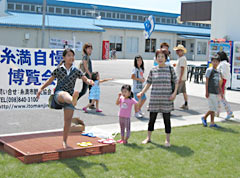
July 23, 2012 Ryukyu Shimpo
From October 27 to November 18, the All Southern Okinawa Expo, in which people can enjoy sightseeing options featuring the tradition and culture of the southern part of Okinawa will be held for the first time. There will be peace-education programs, bus tours to visit communities holding dragon-boat races, and over 100 tourism options such as sightseeing in towns guided by the local residents. It is hoped that it will help to revitalize southern Okinawa using the tourism resources of each area.
A total of four cities and three towns will co-host the event: Naha, Tomigusuku, Itoman, Nanjo, Yaese, Yonabaru and Haebaru. The exposition is an extension of the Itoman Charms Expo, which has been held in Itoman since 2010. The executive committee hopes that it will also help promote the 32nd Japan Bountiful Ocean Festival, which will be held in Itoman on November 17 and 18.
The event’s organizer, the Itoman City Tourism Association will organize marine sports, flower arrangements, fishing cruising tours and a cooking class for shikamasand, a large sandwich sold at the roadside station in Itoman. Seiichi Kaminaka, a staff member of the association, said, “By utilizing locations near to the airport, we would like to offer experience-options that people can enjoy even they only have a few hours to spare.”
A charge will be involved for all of the options. The official program of each community will be decided beyond the end of July. For further information, call the organizer at 098 (840) 3100.
(English translation by T&CT, Lima Tokumori and Mark Ealey)
Go to japanese
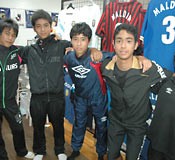
July 19, 2012 Ryukyu Shimpo
Five junior high-school students who belong to a football club in Nago, Escuela de Barbie Futbol, will go to Argentina for two weeks from August 10. They are looking forward to their experience in the home of football.
When he was in his teens, the head of the club Kazushi Oshiro belonged to the football club called the Flandria in Lujan, in the suburbs of Buenos Aires, and he has stayed in contact with people now in its executive who were his teammates back then. The children from Nago will take part in the club’s youth team practices and go to watch games of Argentinian first division teams.
To date, Oshiro has helped a total of 20 people to go abroad to improve their football skills. “Playing football is important of course, but I hope that they will grow as young people through contact with a different culture,” he said.
Agarie Junior High School third-year student Sho Kishimoto said, “I would like to find out what drives them to be so determined in Argentina.” Fuki Matayoshi said, “I would like to experience all sorts of challenging things that cannot be done in Japan.” Shoichiro Higashi said, “I hope to experience the passion of the
Argentines for soccer and to see their unique playing style.”
Kohei Kishimoto in the third year of Nago Junior High School said, “I am looking forward to playing with boys of my age players.” Raimu Higa in the first year at the same school said, “I would like to learn how they use their bodies on the field.”
(English translation by T&CT, Lima Tokumori and Mark Ealey)
Go to Japanese
July 25, 2012 Hideki Matsudo of Ryukyu Shimpo reports from Washington D.C.
On July 23, the head of the Executive Office of the Governor, Susumu Matayoshi, who is traveling in the United States, met with U.S. government officials and expressed the opposition of the Okinawa Prefectural Government (OPG) to the deployment of the MV-22 Osprey vertical take-off and landing transport aircraft to MCAS Futenma. Matayoshi said, “We oppose the deployment plan because the people of Okinawa are worried about the safety of the aircraft.” According to Mayayoshi, U.S. government officials indicated that they understood the concern of the Okinawan people, but stated that the U.S. government would not change the schedule for deployment.
Matayoshi met Christopher Johnstone, the Pentagon director for Northeast Asia, and Marc Knapper, director of the Office of Japanese Affairs at the State Department. After the meetings, Matayoshi answered questions asked by reporters in Washington D.C. Considering the fact that Osprey aircraft have had more than one crash this year, Matayoshi told the U.S. officials about the plan to stage a protest rally on August 5 in Okinawa against the deployment. He told them about the tense situation in Okinawa regarding the issue, saying, “The event will represent a major declaration of intent on the part of the Okinawan people.”
However, in response the U.S. officials asserted that the transport aircraft is necessary for the defense of Japan, and went on to say that they intend to work on easing the concerns of the Okinawan people before commencing operation of the aircraft in October.
Matayoshi explained that the excessive burden placed on Okinawa by the prefecture’s hosting of the bulk of U.S. military facilities in Japan and the Okinawan people’s concerns over the risk posed due to the presence of Futenma Air Station sit in the background to this issue. He also passed on Okinawa Governor Hirokazu Nakaima’s call for the easing of the burden and the relocation of the air base out of Okinawa.
(English translation by T&CT, Mark Ealey)
Go to Japanese
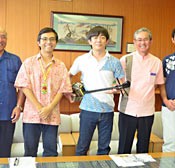
July 19, 2012 Ryukyu Shimpo
The 100-year Project to create a forest of kuroki in Yomitan has started with the aim of planting young trees of ebony or kuroki for sanshin on an ongoing basis beyond the current generation. The project aims to produce sanshin using local Okinawan materials because in recent years many sanshin are made using imported ebony. On July 16, Kazufumi Miyazawa, the honorary chairman of the organizing committee, vocalist of the band The Boom, and Chairperson Denjitsu Ishimine, who is also the mayor of Yomitan, held a press conference at the Yomitan Village Office.
Miyazawa proposed the project to give something back to Okinawa, as this year marks the 20th anniversary of his hit song Shimauta, which was set in Okinawa. “We would like to support this project by holding events and planting trees. At times we may struggle along the way, but I believe that we can overcome them if we think of what things might be like 100 years from now,” he said.
The project’s target year of 2108 marks the 200th anniversary year of municipal government being set up in Yomitan. Mayor Ishimine said, “I hope that this forest of kuroki will grow well. We hope that many children will join us so we can hand on these activities to future generations.”
Miyazawa has been making commemorative CDs by recording the music of Okinawan folk singers who are now growing old. The organizing committee intends to establish a fund to support the project and to cooperate with children attending local sanshin classes. The committee is seeking to recruit supporters for the project.
(English translation by T&CT, Lima Tokumori and Mark Ealey)
Go to Japanese
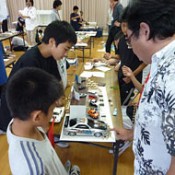
July 15, 2012 Takahiro Shinjo, Correspondent of the Ryukyu Shimpo
On June 27, in an art class at Kaneshi Elementary School in Nakijin, 26 sixth-grade pupils took part in a special workshop, to create models of their dream shop. The children designed a variety of shops for motorcycles, cars, sports goods, and pets.
Members of the Japanese Commercial Environment Designers Association (JCD) delivered the lecture to the class. The establishment of the JCD Okinawa branch has led to the commencement of a range of activities to support education with design. This was the second such class following one held at Bito Elementary
School in Okinawa City in 2010.
Before the class, the pupils drew sketches of shops they would like to have and thought of what materials they might use. They worked with sample tile, stainless steel sheeting and cloth, just as professionals would do.
To start with the children just followed the teacher’s guidance, but after a while they focused on the task at hand and created the models by themselves, presenting their work at the end of the class. Asahi Yonamine, who made a model of a car shop, said, “The wall and the floor were different from I had imagined, but I’m happy with how it turned out.” Chikara Shindo, an interior designer from Tokyo, commented, “People tend to think that design is difficult, but it’s really just like cooking. It would be nice if the children come to understand the joy of creating something.”
Sixth-grade teacher Yoshie Yamashiro said, “It is a good opportunity for children to enjoy making something and getting an idea of a potential career through contact with professional architects and designers.”
(English translation by T&CT, Lima Tokumori and Mark Ealey)
Go to Japanese
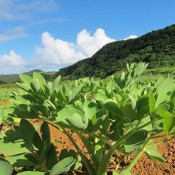
July 21, 2012 Maki Nagamine of Ryukyu Shimpo
The volume of production is increasing of peucedanum japonicum, or the longevity herb, a Yonaguni Island herb long known to have medicinal properties. From 2005 to 2010, annual production in Okinawa has grown 8.1 times to 26.6 tons, and the area harvested has increased 4.5 times to 25.4 hectares. In the background to this sharp rise is the fact that Yonaguni, which supplies 95% of the production in Okinawa, developed its production system thanks to budget provided by the national government and the fact that they have made the herb available as a raw material to Shiseido, a major cosmetics company in Tokyo. It is expected that following on from turmeric and aloe, the herb will go on to become another significant medicinal crop for Okinawa.
In 2005, hoping to become a production hub for prefectural-certified agricultural, forestry and fisheries items, the Yonaguni local authorities established a production area council for peucedanum japonicum comprising local government officials, farmers and members of the Japan Agricultural Cooperatives. This has served to strengthen links among producers, manufacturers and distributors and status as a prefectural-certified area of hub production was granted in 2006.

The annual production volume in Okinawa of the peucedanum japonicum and the area harvested.
In 2010, they set up a producer-manufacturer’s agricultural group called the Yonaguni Herb Farm using the national fund for revitalizing mountain, agricultural and fishing communities, and launched the Yonaguni Producer Association for peucedanum japonicum. These activities all combined to help establish a stable production system.
As a result, the annual production of the herb in Okinawa in 2005 of 3.3 tons had increased to 26.6 tons by 2010. The area harvested also surged from 5.6 hectares to 25.4 hectares and production is now approaching the 2009 levels of the other medicinal crops in Okinawa of turmeric, 55.1 tons, and aloe, 34.2 tons.
A spokesperson for the Yonaguni Industry Promotion Division, where the council headquarters are located, commented, “To prevent the unwelcome effects of agricultural chemicals and to improve the herb’s quality we will build fences in situations where we plant the trees between sugarcane farms.”
Shiseido is marketing health foods made solely from Yonaguni’s peucedanum japonicum as the Shiseido Longevity Herb in the three forms of tablets, a drink and a powder. Sales from this April to June increased about 40% over the same period the previous year. They decided upon the production volume after discussing the quantity needed each year with the council, thereby helping to secure a stable income for the local farmers.
During fiscal 2005 to 2011, the number of farmers in Yonaguni also grew by 13 families to a total of 50 families and the production value grew by about 2.5 million yen to about 33.1 million yen.
A spokesperson for Shiseido said, “As the volume of sales increase, more raw materials will be required in the future. We want to promote the Longevity Herb brand.”
(English translation by T&CT, Lima Tokumori and Mark Ealey)
Go to Japanese
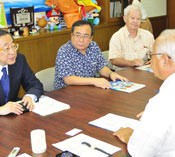
July 18, 2012 Ryukyu Shimpo
This year, at a bioethanol production factory at Shimoji, Miyako-jima City Tokyo-based merchandising company the Japan Alcohol Corporation will commence ethanol production and research into the conversion of byproducts into fertilizer. In 2010, at a cost of approximately four billion yen, the Ministry of Environment built a factory in Miyako-jima City in order to carry out verification tests. Since the project finished in 2011, the authorities have been searching for ways to make use of the factory and asked the company to manage the project.
On July 17, Jiro Amagai, the president of the company, visited Mayor Toshihiko Shimoji at the municipal office in Hirara and explained the company’s plans.
The factory currently belongs to the government, but it will be placed under the control of Miyako-jima City, which will then entrust the corporation with its management. The Miyako-jima Municipal Office is seeking to expedite the establishment of the conditions required to commence such management before the end of this fiscal year, and is also planning to use the factory for human-resource development and environmental education.
The corporation produces bioethanol at a factory in Kagoshima Prefecture and makes fertilizers using the byproducts. Amagai said, “In Miyako-jima, there could be a viable business if byproducts can be converted to fertilizers and have value added to them.” He hopes to create a profitable operation within the next five years. Mayor Shimoji expressed his full support for the initiative.
(English translation by T&CT, Megumi Chibana and Mark Ealey)
Go to Japanese
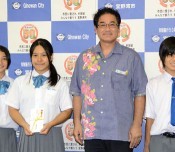
July 18, 2012 Kenta Masuda of Ryukyu Shimpo
Sol-T-shine, a dance group from the Tida Dance Studio in Chatan, gained entry to the World Hip-Hop Championship 2012 to be held on August 1 in Las Vegas, which is known as the dance Olympics.
The group consists of eight elementary school and junior high-school pupils. On July 9, three of them, who attend Ginowan Junior High School, Hinano Nishihara, Nanase Tomimura, and Hijiri Matsudo, visited Ginowan Mayor Atsushi Sakima to pledge that they will do their best.
According to their instructor, Natsumi Fukumoto, approximately 300 teams from 40 countries will participate in the competition. Fukumoto introduced the members as very keen dancers who clearly are excited when taking part in practice.
The members of the dance group told the mayor that they aim to become the best in the world. Mayor Sakima encouraged them to aim for the top and hoped that they have a wonderful experience at the competition. The Ginowan Municipal Office presented the group with a gift of 20000 yen.
At 5:00pm on July 22 an event will be held to wish them well at the music and dance venue called ando in Chatan.
(English translation by T&CT, Megumi Chibana and Mark Ealey)
Go to Japanese
July 18, 2012 Ryukyu Shimpo
On November 17, Defense Minister Satoshi Morimoto commented that he had no accurate data on the flight distance capability of the MV-22 Osprey vertical take-off and landing transport aircraft using autorotation to avoid dangerous situations in an emergency. This comment indicates that the Ministry of Defense has not received such important information on the safety of the Osprey aircraft prior to the MV-22 squadron’s deployment to Okinawa.
Travel distance using the autorotation function is a measure of the aircraft’s ability to avoid a dangerous situation or a crash in a city in an emergency. In the guidebook for the Osprey deployment published by the Ministry of Defense, the ministry emphasized the aircraft’s safety, stating that, “when the Osprey aircraft falls in the emergency landing, the pilot will opt for the fixed-wing aircraft mode to glide or the helicopter mode to perform auto-rotation.” However, this is not a convincing explanation because the Ministry of Defense has not acquired data on the Osprey flight distance capability on autorotation.
The guidebook gives information in question and answer style, and with regard to the safety of the aircraft, there is the question, “If both engines of the Osprey aircraft failed during flight, what does the pilot do to cope with the situation?” The answer is given as, “The pilot will manoeuver the aircraft using either autorotation or gliding.” With regard to this explanation, Arthur Rex Rivolo, a former chief analyst of the Institute for Defense Analyses commented that this is for the helicopters, not for the Osprey aircraft. He said, “The airplane won’t do an autorotation.” The Bell Boeing company that developed the Osprey aircraft explains in the guidebook that the MV-22 will not rely the autorotation function during emergency situations. Some written testimonies and reports rejecting the content of the guidebook issued by the Defense of Ministry have been published in the United States.
The Ministry of Defense explains in its report published in August 2007 that helicopters currently operating from Futenma Air Station are able to fly 750 meters using the autorotation function when flying at an altitude of 330 meters. This report was put together by the Ministry of Defense, based on discussions between the governments of Japan and the United States after a helicopter crashed into the campus of Okinawa International University.
“The Osprey’s gliding distance will depend on whether it is in fixed-wing mode or helicopter mode. Now I have been studying expert opinion on some points, including how far the vertical take-off and landing aircraft can travel using its autorotation function from a certain altitude. I pose questions to the United States,” the Defense Minister said.
(English translation by T&CT, Mark Ealey)
Go to Japanese
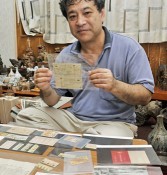
July 22, 2012 Taichi Hirayasu of Ryukyu Shimpo
Chatan resident Shigeo Teruya, a self-employed worker who collects Okinawan valuable paper materials, acquired tickets and commuter passes of the street-car that operated in Okinawa for about 20 years from 1914. Referring to the fact that the street-car operated for a relatively brief period, essayist Yutaka Hajime, who is acquainted with the history of railroad in Okinawa, said, “It is very rare to come across an actual ticket.” Teruya and Hajime both said that they have never seen actual tickets that were publicly exhibited.
The street-car commenced operation in May 1914 and is said to be the first form of public transport in Okinawa because it started seven months earlier than the light railway that had commenced operation in December of the same year. The street-car ran for about seven kilometers from Shuri to Sakashita, Sogenji and Nishinjo, with Tondo at the end of the line. It ceased operation in 1933 because of the increased use of buses in Okinawa.
Teruya acquired a large number of materials, including commuter tickets, student tickets and postcards depicting the street-cars. He also owns timetables and tickets of the light rail system.
Teruya said that he found all of the items in antique shops and auctions outside of Okinawa.
He has collected stamps since he was in elementary school, and started collecting items related to the street-car and railroad about 20 years ago. While collecting them, Teruya came to sense that they were very rare. He has also collected many tickets and photographs and says, “In future, I would like to look for tickets of the horse-drawn streetcar that operated between Yonabaru and Awase, and for street-car timetables.”
Hajime said, “Although many people know that the light railway operated until the Battle of Okinawa, the existence of the street car was barely known because it only operated for a brief period.” With regard to street-car tickets, Hajime said, “Although I have seen copies of these tickets, this is the first time for me to see an actual ticket. It is really valuable.”
(English translation by T&CT, Mark Ealey)
Go to Japanese

Go To Video
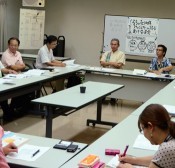
July 16, 2012 Wakako Oshiro of Ryukyu Shimpo
Kuroki (kuruchi or Ryukyu kokutan) is an essential material for making the famous Okinawan musical instrument, the sanshin. To change the current situation that most kuroki are imported, “Kuruchi Forest 100 year Project in Yomitan” set off to plant kuroki in Okinawa. Kazufumi Miyazawa, a vocalist from The Boom known for their hit song, Shimauta, suggested this project. Using the profit from annual events and commemorative CD sales, the project offers a grand design for the planting of kuroki every year continuously for one hundred years. As the first event of the project, a concert will be held on October 20.
In the afternoon on 16th, the executive committee of the project and Miyazawa will have a press conference.
For three years since 2008, Nomura Ryu Koten Ongaku Hozonkai and Yomitan have planted 2500 kuroki trees in Zakimi Castle Park. With volunteers’ involvement, two projects became one and started in Yomitan. Their goal is in 2108 to be able to play sanshin made from locally grown kuroki.
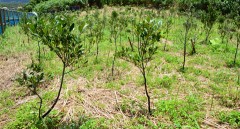
Kuruchi Forest at Zakimi Castle Park in Yomitan.
On June 25 at the Village’s culture center, 20 volunteers gathered and held the first executive committee meeting. Miyazawa acted as honorary chairman and Mayor Denjitsu Ishimine was appointed as the chairman. Director of the Okinawa Prefecture Division of Culture, Tourism, and Sports, Daiichi Hirata became an advocate.
In the 20th year from the birth of the song Shimauta, Miyazawa suggested the kuroki as a tree- planting project to Hirata as Miyazawa’s repayment to Okinawa, which had contributed to his development. He is currently working with 100 supporting artists to make a commemorative CD.
Kuroki grows slowly taking several decades before it can be used as material to make sanshin. Materials taken from demolished houses are sometimes recycled, but most sanshin are made using wood imported from Taiwan and Vietnam.
(English translation by T&CT, Megumi Chibana and Mark Ealey)
Go to Japanese












 Webcam(Kokusai Street)
Webcam(Kokusai Street)


